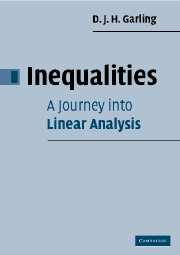Book contents
- Frontmatter
- Contents
- Introduction
- 1 Measure and integral
- 2 The Cauchy–Schwarz inequality
- 3 The AM–GM inequality
- 4 Convexity, and Jensen's inequality
- 5 The Lp spaces
- 6 Banach function spaces
- 7 Rearrangements
- 8 Maximal inequalities
- 9 Complex interpolation
- 10 Real interpolation
- 11 The Hilbert transform, and Hilbert's inequalities
- 12 Khintchine's inequality
- 13 Hypercontractive and logarithmic Sobolev inequalities
- 14 Hadamard's inequality
- 15 Hilbert space operator inequalities
- 16 Summing operators
- 17 Approximation numbers and eigenvalues
- 18 Grothendieck's inequality, type and cotype
- References
- Index of inequalities
- Index
Introduction
Published online by Cambridge University Press: 06 July 2010
- Frontmatter
- Contents
- Introduction
- 1 Measure and integral
- 2 The Cauchy–Schwarz inequality
- 3 The AM–GM inequality
- 4 Convexity, and Jensen's inequality
- 5 The Lp spaces
- 6 Banach function spaces
- 7 Rearrangements
- 8 Maximal inequalities
- 9 Complex interpolation
- 10 Real interpolation
- 11 The Hilbert transform, and Hilbert's inequalities
- 12 Khintchine's inequality
- 13 Hypercontractive and logarithmic Sobolev inequalities
- 14 Hadamard's inequality
- 15 Hilbert space operator inequalities
- 16 Summing operators
- 17 Approximation numbers and eigenvalues
- 18 Grothendieck's inequality, type and cotype
- References
- Index of inequalities
- Index
Summary
Inequalities lie at the heart of a great deal of mathematics. G.H. Hardy reported Harald Bohr as saying ‘all analysts spend half their time hunting through the literature for inequalities which they want to use but cannot prove’. Inequalities provide control, to enable results to be proved. They also impose constraints; for example, Gromov's theorem on the symplectic embedding of a sphere in a cylinder establishes an inequality that says that the radius of the cylinder cannot be too small. Similar inequalities occur elsewhere, for example in theoretical physics, where the uncertainty principle (which is an inequality) and Bell's inequality impose constraints, and, more classically, in thermodynamics, where the second law provides a fundamental inequality concerning entropy.
Thus there are very many important inequalities. This book is not intended to be a compendium of these; instead, it provides an introduction to a selection of inequalities, not including any of those mentioned above. The inequalities that we consider have a common theme; they relate to problems in real analysis, and more particularly to problems in linear analysis. Incidentally, they include many of the inequalities considered in the fascinating and ground-breaking book Inequalities, by Hardy, Littlewood and Pólya, originally published in 1934.
The first intention of this book, then, is to establish fundamental inequalities in this area. But more importantly, its purpose is to put them in context, and to show how useful they are.
- Type
- Chapter
- Information
- Inequalities: A Journey into Linear Analysis , pp. 1 - 3Publisher: Cambridge University PressPrint publication year: 2007



